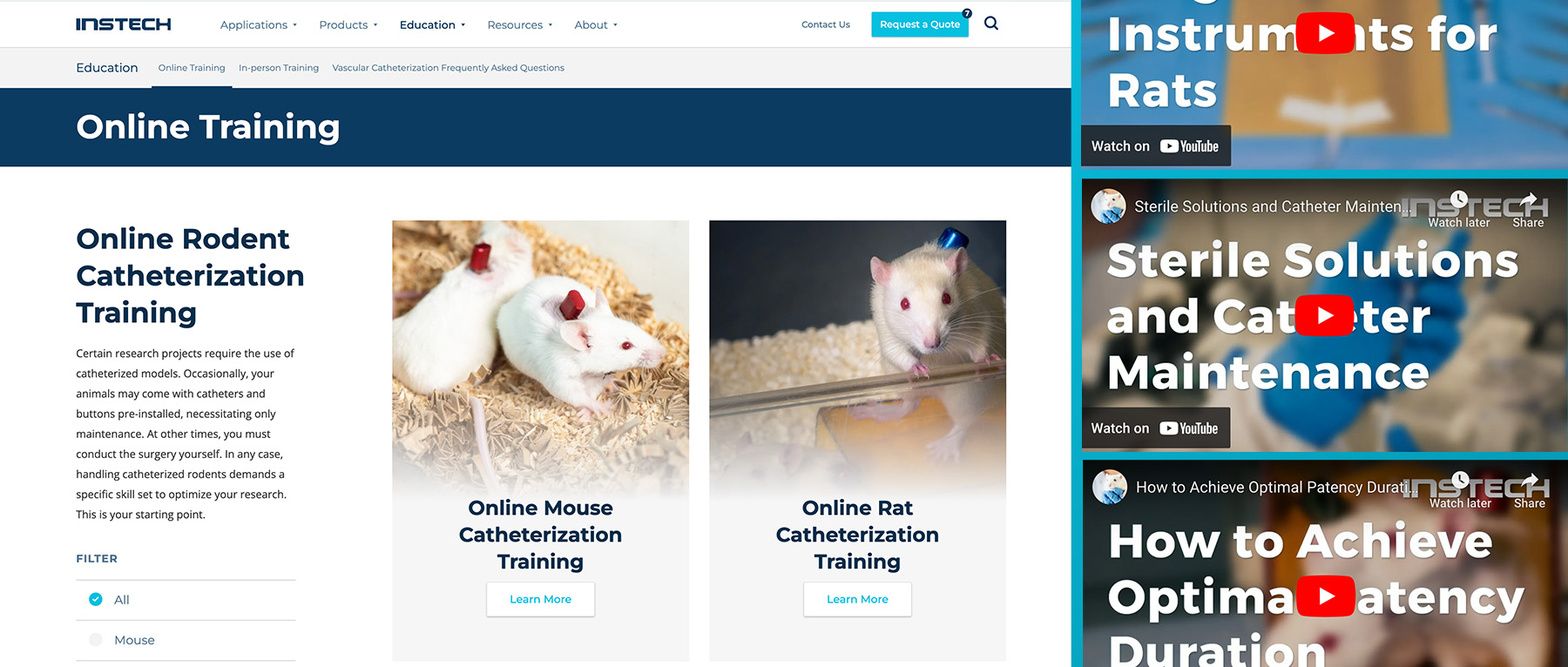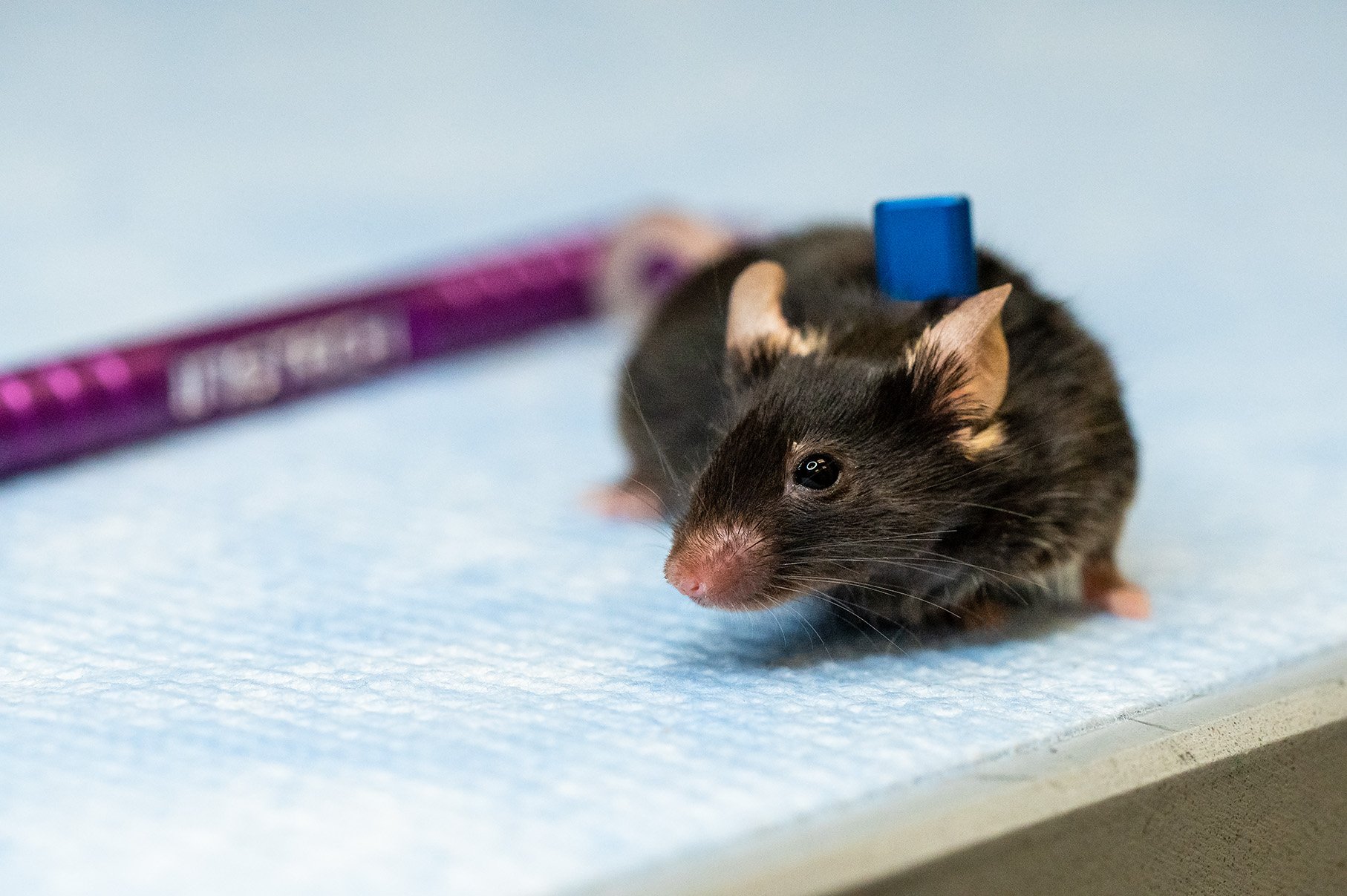Rodent catheterization raises many questions to mind, particularly regarding surgical equipment and instruments, animal recovery and catheter patency. What surgical equipment should I use? Which tools influence surgical outcomes and animal recovery? What surgical instruments are recommended? How can I minimize trauma during surgery? And what strategies can help extend catheter patency duration? The simple fact of using the right tools can reduce complications, promote animal recovery, and significantly extend catheter patency duration.
Beyond surgical equipment and instruments, selecting the appropriate vascular access device, catheter, and solution plays an essential role in achieving successful surgical outcomes and maximizing catheter patency duration.
Using the Right Surgical Equipment
 Having all the necessary surgical equipment ready before starting a procedure is a must. One of the most important tools for rodent surgery is a surgical microscope. While it’s possible to perform catheterization without one, particularly in rats, the level of fine detail that goes unnoticed by the naked eye can lead to unnecessary trauma. A microscope not only supports ergonomic posture for the surgeon but also enables atraumatic surgical technique, which in turn promotes smoother animal recovery. There are many options and several reliable microscope brands on the market, including Leica, Nikon, and Olympus. Choosing a model with a tilting binocular head promotes better ergonomic posture, while a boom stand provides a flat working surface for greater ease during procedures. Be sure to use a high-quality light source alongside your microscope for optimal visualization.
Having all the necessary surgical equipment ready before starting a procedure is a must. One of the most important tools for rodent surgery is a surgical microscope. While it’s possible to perform catheterization without one, particularly in rats, the level of fine detail that goes unnoticed by the naked eye can lead to unnecessary trauma. A microscope not only supports ergonomic posture for the surgeon but also enables atraumatic surgical technique, which in turn promotes smoother animal recovery. There are many options and several reliable microscope brands on the market, including Leica, Nikon, and Olympus. Choosing a model with a tilting binocular head promotes better ergonomic posture, while a boom stand provides a flat working surface for greater ease during procedures. Be sure to use a high-quality light source alongside your microscope for optimal visualization.
Another increasingly standard piece of equipment in rodent surgery is an anesthesia system. As injectable anesthetics fade away, specialized inhalant anesthesia systems are now designed specifically for rodents. Inhalant anesthesia offers several advantages, including the ability to adjust anesthetic concentrations to maintain the correct stage and plane of anesthesia throughout the procedure. This minimizes the risk of overdosing, common with injectable agents, and aligns with the 3Rs principles. Moreover, gas anesthesia allows for rapid recovery, enabling animals to regain mobility and resume eating and drinking much sooner after surgery, enhancing animal welfare.
Additional essential equipment includes a hot bead sterilizer, used to sterilize instrument tips between surgeries, and reliable heat sources to keep rodents warm from anesthesia induction through recovery. Maintaining body temperature is critical for reducing physiological stress and supporting a smooth postoperative outcome.
Anesthesia System:
Bead Sterilizers:
Warming Systems:
- Warming Systems - Stoelting
- Far Infrared Warming Pads with Controller - Kent Scientific
- Heat Therapy Pump - Adroit Medical Systems
- Rodent Incubator - Powers Scientific
Using the Right Surgical Instruments
 Surgical instruments for mice and rats should be appropriately sized for the specific species being operated on. For example, instruments designed for rats are too large for mice. Using instruments of the wrong size can cause unnecessary trauma by increasing the risk of tissue damage and prolonging the duration of the surgery.
Surgical instruments for mice and rats should be appropriately sized for the specific species being operated on. For example, instruments designed for rats are too large for mice. Using instruments of the wrong size can cause unnecessary trauma by increasing the risk of tissue damage and prolonging the duration of the surgery.
Not all surgical instruments are created equal. Their quality and price can vary significantly. Generally, higher-quality instruments are more expensive, but they perform better and last longer, making them a worthwhile investment. Proper care and maintenance are essential to preserve instrument performance. Keeping scissors sharp and ensuring forceps tips remain well-aligned contribute to an atraumatic and efficient surgical procedure.
Surgical Instruments:
Using the Right Vascular Access System
 There are several methods to access the vascular system, as well as other organs, ducts, and spaces that require catheterization. The chosen access method significantly impacts the patency duration of the system. Traditionally, catheters were exteriorized, typically between the shoulder blades of the animal. However, this outdated technique creates an open system that is highly susceptible to infection and fluid evaporation through the exposed catheter walls. Such exposure to the environment results in reduced catheter patency.
There are several methods to access the vascular system, as well as other organs, ducts, and spaces that require catheterization. The chosen access method significantly impacts the patency duration of the system. Traditionally, catheters were exteriorized, typically between the shoulder blades of the animal. However, this outdated technique creates an open system that is highly susceptible to infection and fluid evaporation through the exposed catheter walls. Such exposure to the environment results in reduced catheter patency.
Over time, a range of methods have been developed to enhance vascular access. These include homemade devices, jackets, harnesses, ports, and transcutaneous buttons. Among these options, some have proven more effective and practical than others. For optimal performance, the transcutaneous button, such as the Vascular Access Button™, represents the latest advancement in vascular access technology. This closed system not only extends catheter patency duration but also enhances animal welfare and supports the principles of the 3Rs by Reduction and Refinement.
In short, the Vascular Access Button™ is the right tool for modern, ethical, and effective vascular access.
Vascular Access Systems:
Using the Right Catheters
 Both the catheter material and tip profile are important factors to be considered.
Both the catheter material and tip profile are important factors to be considered.
The most common tubing materials are Silicone (Sil), Polyethylene (PE), and Polyurethane (PU). Silicone is highly permeable and should not be used as an exteriorized catheter unless there is continuous fluid flow. While it is soft and flexible, it can slip off connectors easily and is prone to puncture. Polyethylene is generally unsuitable for intravascular use due to its stiffness. Polyurethane is the most used material for rodent catheters due to its biocompatibility and its performance in subcutaneous connections, such as those with the Vascular Access Button™.
The catheter tip profile directly affects endothelial cell damage during insertion. A blunt or beveled tip causes more damage than a rounded tip. Beveled tips should not be used for vascular catheterization, while blunt tips are acceptable only when rounded tips are unavailable (e.g., for 1Fr catheters). Studies show that rounded-tip catheters increase patency duration by minimizing endothelial injury and reducing the risk of blood clot formation.
Catheters:
Using the Right Solutions
 When it comes to flush and lock solutions, the most important consideration is to use sterile, pharmaceutical-grade solutions. Even if strict aseptic technique is followed during surgery, introducing non-sterile solutions into the bloodstream can compromise the health of your animals.
When it comes to flush and lock solutions, the most important consideration is to use sterile, pharmaceutical-grade solutions. Even if strict aseptic technique is followed during surgery, introducing non-sterile solutions into the bloodstream can compromise the health of your animals.
Commonly used flush solutions include sterile isotonic saline and sterile heparinized isotonic saline, typically at low heparin concentrations of 10–20 USP/mL. These solutions are used during surgery, for catheter maintenance, or after compound infusion.
When using a VAB™, the heparinized saline flush solution at 10–20 USP/mL is increasingly popular as a lock solution, particularly within the venous system. In the arterial system, the viscosity of the heparin/glycerol locks may offer benefits, and our new low-heparin formulation of 50 USP/mL reduces the risk of introducing hazardous amounts of heparin into the bloodstream. There are no strict rules regarding which solutions work best in different species or vessels, so it is important to select the lock solution that is most suitable for your specific needs while exercising caution when using high-concentration heparin solutions.
Sterile Solutions:
In rodent catheterization, success ultimately depends on the sum of many precise choices — from surgical equipment and instrument quality to the type of vascular access, catheter, and lock solution used. Each decision contributes to minimizing trauma, promoting animal recovery, and extending catheter patency. By embracing modern tools like the Vascular Access Button™, maintaining meticulous technique, and selecting appropriate materials and solutions, researchers can achieve more consistent outcomes while upholding the highest standards of animal welfare and scientific integrity.
All these topics, and more, are covered in our Online Rodent Catheterization Training courses.

